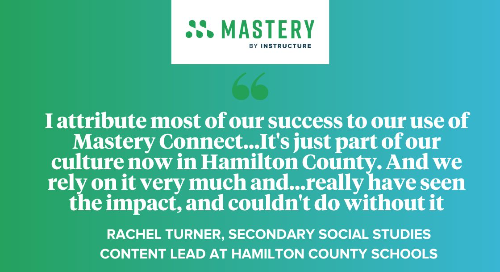
Our VP of K12 Strategy here at Instructure, Trenton Goble, often says, “If we solicit data from kids, we have a moral obligation to use that data to benefit kids.”
In today’s evolving assessment landscape, we are now able to deliver on this important mantra. More and more school districts are moving away from high stakes testing to higher-quality assessments that deliver meaningful, actionable data; data that can impact learning in real-time.
This shift is great to see, but only if teachers understand how to effectively use assessment data to benefit students. When they do, teachers view high-quality assessments as an integral part of the instructional process with assessment data positively and directly impacting the student and classroom.
How to Use Meaningful Assessment Data to Inform Instruction
Not all assessment data is the same. While teachers more often than not have access to a large amount of student data, it’s important that they use that which can make the most student achievement gains in the classroom.
Meaningful assessment data delivers a snapshot of what students know, what students should know, and what students do not yet know. When teachers understand this assessment data, they are positioned to make decisions that inform instruction and positively affect student outcomes.
Data-driven assessment is only valuable when the data is actionable. A continuous feedback loop that consists of planning, teaching, assessing, and adapting can help drive meaningful data-driven instruction.
Here are four ways teachers can leverage assessment data in their classroom:
1. To Better Understand Where Students are in their Learning
Assessments that are solely used as a measurement of learning do not benefit students in a timely manner; assessments for learning however are game changers! Formative assessment, which includes things like short quizzes, exit tickets, thumbs-up/thumbs-down, and interviews give teachers learning feedback in the moment on where students are in their learning. It gives the teacher the ability to make adjustments to their teaching so that no students are left behind.
Understanding where students are in their learning in today’s current education landscape with the pandemic is critical, and assessments for learning – like formative assessment – can deliver on this ideal.
2. To Adjust Instruction Based on Feedback
The ability for teachers to adjust their instruction to meet the needs of students is paramount. Assessment data should be viewed as a tool for guiding further instruction and evaluating how teachers can improve their own classroom practice. Immediate assessment feedback can help teachers deliver on this principle by answering the question, “Where are we in our learning today and what do we need to improve on tomorrow?”
Immediate feedback can also help teachers adjust their instruction to meet individual student needs as well as group students based on their progress. This can facilitate remediation groups that may be in need of intervention strategies or acceleration groups that might benefit from deeper learning.
3. To Use as a Springboard for Collaboration
Professional Learning Communities (PLCs) give school districts the framework to improve educational outcomes through teacher collaboration. Assessment data can serve as the foundation for PLCs when reflecting on instructional practices and teacher strategies, and help answer the key questions, “What do we want students to learn?” and “How will we know if they have learned it?”
4. To Connect with Students
For the sake of students and teachers, assessments need to be reframed. It’s important that students understand assessment doesn’t alway mean grades and test scores. Rather, it’s a way for them to demonstrate what they know and, perhaps more importantly, what they might need more help with.
Use assessment data as a conversation starter with students and help them set academic goals and take responsibility for their learning.
Data driven instruction is critical in today’s education landscape. It can empower teachers, help inform instruction, provide insight into their students’ learning needs, and form the backbone for educator collaboration. The value of the data starts with a smart education assessment system and an understanding of how to leverage the data in the classroom. For more information, download the e-Book – A District Leader’s Guide to Using Data.



